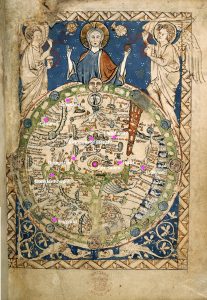Mandeville is especially concerned in this section with the religious history and religious significance of Constantinople. He writes at length about relics that are housed there, including the sponge and reed which Jesus drank from on the cross, one of the nails that held him to the cross, and part of the crown of thorns which he wore as he died (8-10). He also writes about saints who were buried in Constantinople, listing St. Anne, St. Luke the evangelist, and St. John Chrysostom. It seems that he wants his readers to know the fullest extent of Constantinople’s religious heritage, and he picks back up on this a few pages later when he talks about religious differences between Greek and English Christians.
Mandeville also writes about buildings, discussing the Emperor’s palace and drawing attention to its beauty. He claims the palace “is really lovely and beautifully adorned” and notes its practical design features as well as the aesthetic elements, stating that the Emperor’s stables were built underneath tiered seats in a jousting court (using space that may otherwise have been wasted) and that the stables’ pillars were made of marble (12). He draws attention to the wealth of Constantinople through these details, as well as when he describes the geography; he writes that “Constantinople is a very beautiful and great city with strong walls and it is three-cornered” (11). Mandeville seems to make a connection between wealth, beauty, and political strength by listing beauty, greatness, and strength as equal descriptors of the city, and echoes this sentiment when describing the Emperor’s palace.
Mandeville links beautiful buildings with religion in his description of St. Sophie’s church, which he calls “the finest and most beautiful church in the world” (8). He continues to describe a statue of the Emperor Justinian in front of the church. Here Mandeville slips from describing what he sees to reporting what people tell him: he presents a legend about this statue, explaining that it used to hold an apple which represented the emperor’s political power. Mandeville claims that “people have tried many times to put the apple back into the statue’s hand again, but it will not hold it; this apple signifies the lordship he once had over the world” (8). This moment is interesting to me in its intersection of politics and religion; not only does a statue of an emperor stand outside of a church, but the symbolism of a fallen apple reminds me of the fall of Adam and Eve in Christian mythology. I wonder if Mandeville is making an implicit connection that his contemporary readers would have picked up on.
Mandeville states his purpose in recording “things [that] are not relevant to the journey” at the end of this chapter, after he spends three long paragraphs describing the ways Greek Christians differ from English Christians in the ways they practice their faith (13-14). He claims he wants to show his readers differences in faith and culture for entertainment purposes, arguing that “many people take great pleasure and comfort to hear talk of unfamiliar things” (14). This points both to his purpose in writing and what his audience would have found unusual; Mandeville provides an impressive list of the differences in Greek Christianity compared to the Christianity of his readers (13), giving the impression that these details would provide a kind of shock value to his audience.
(pp. 7-14)

